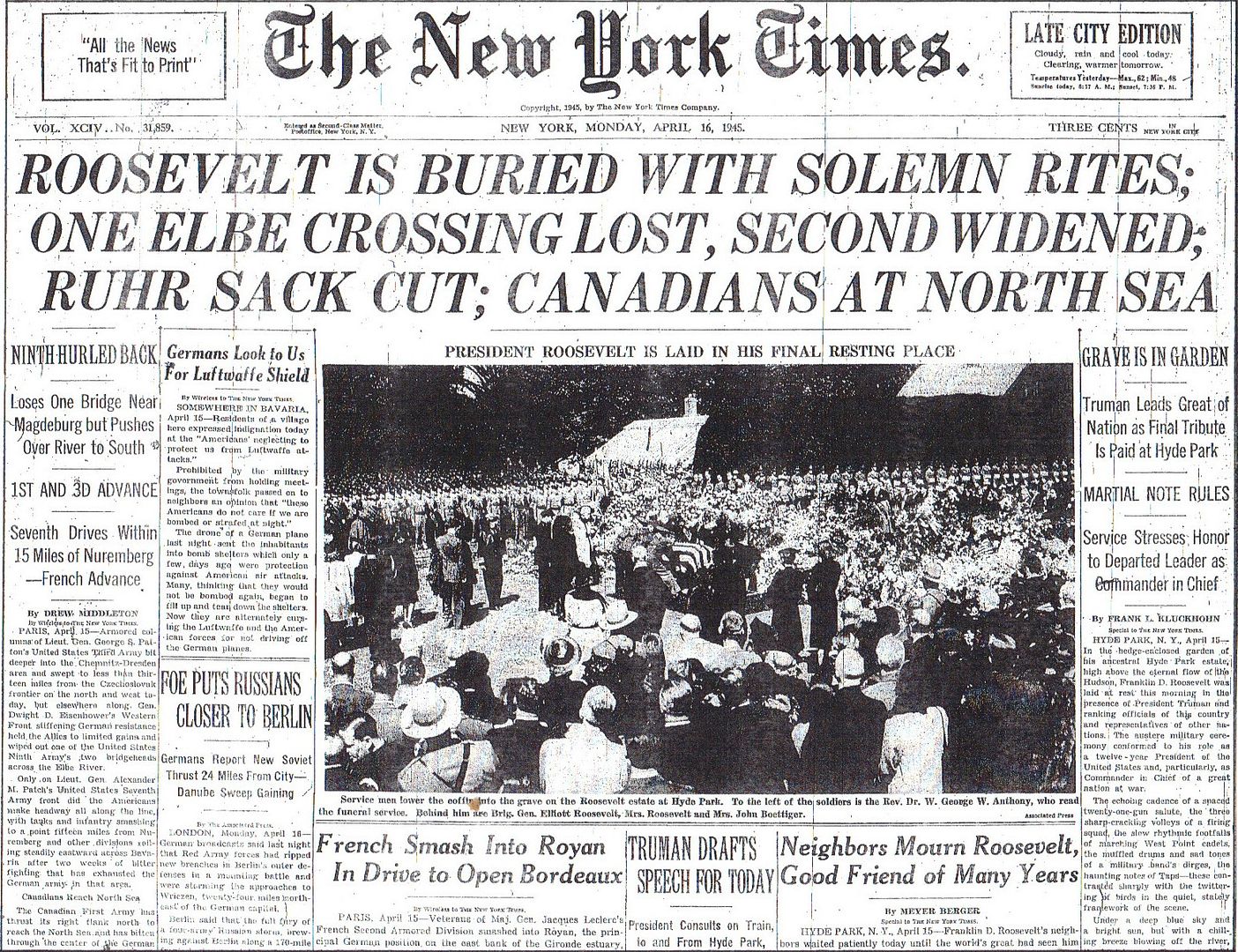
Posted on 04/16/2015 4:43:40 AM PDT by Homer_J_Simpson

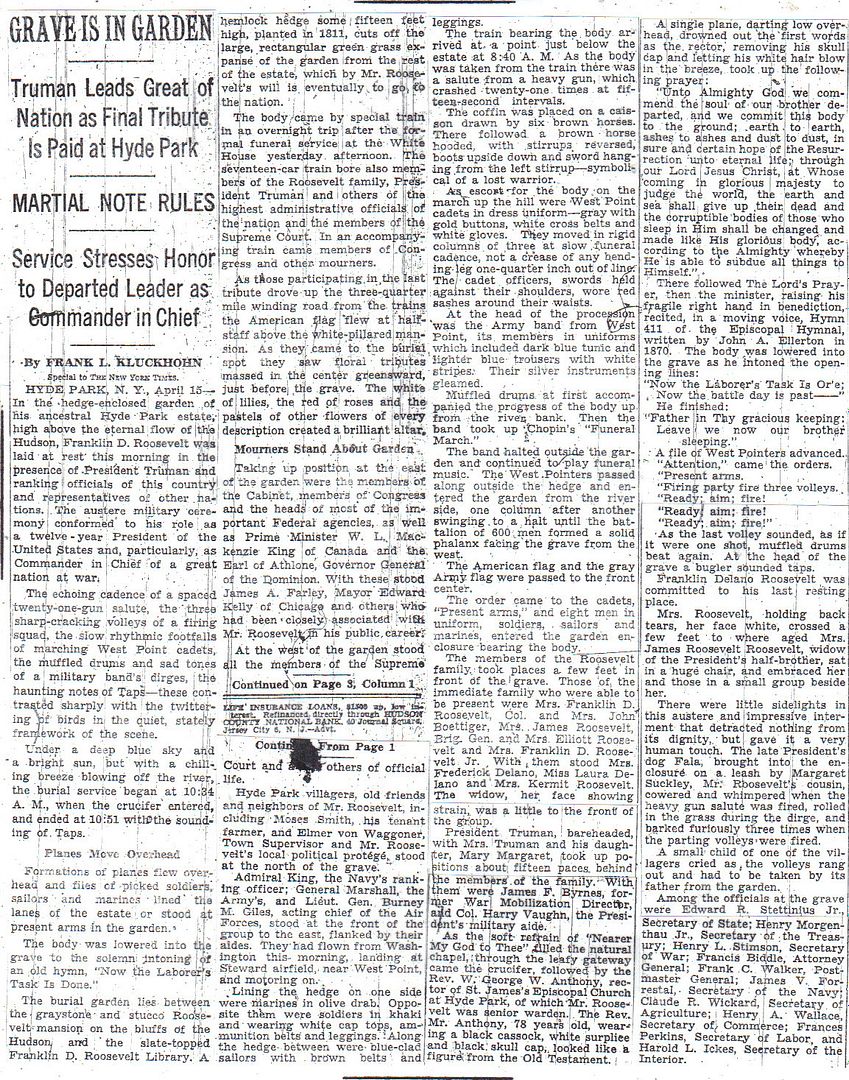
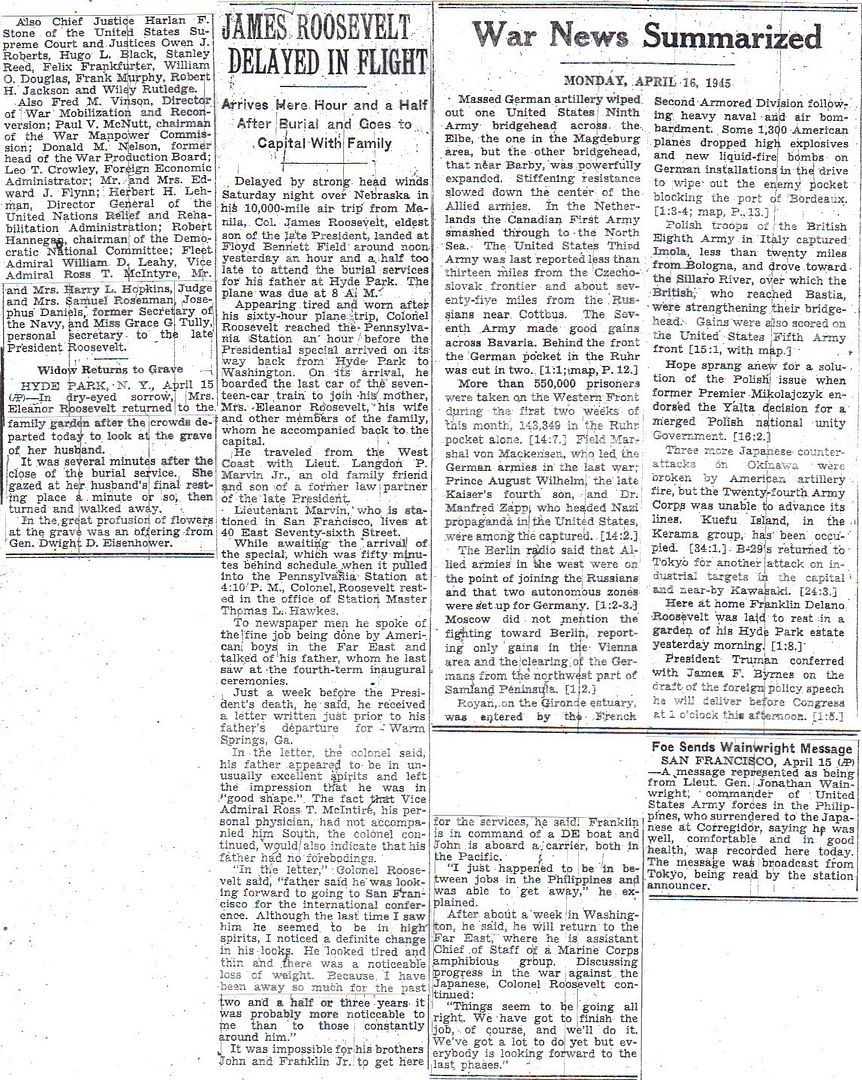
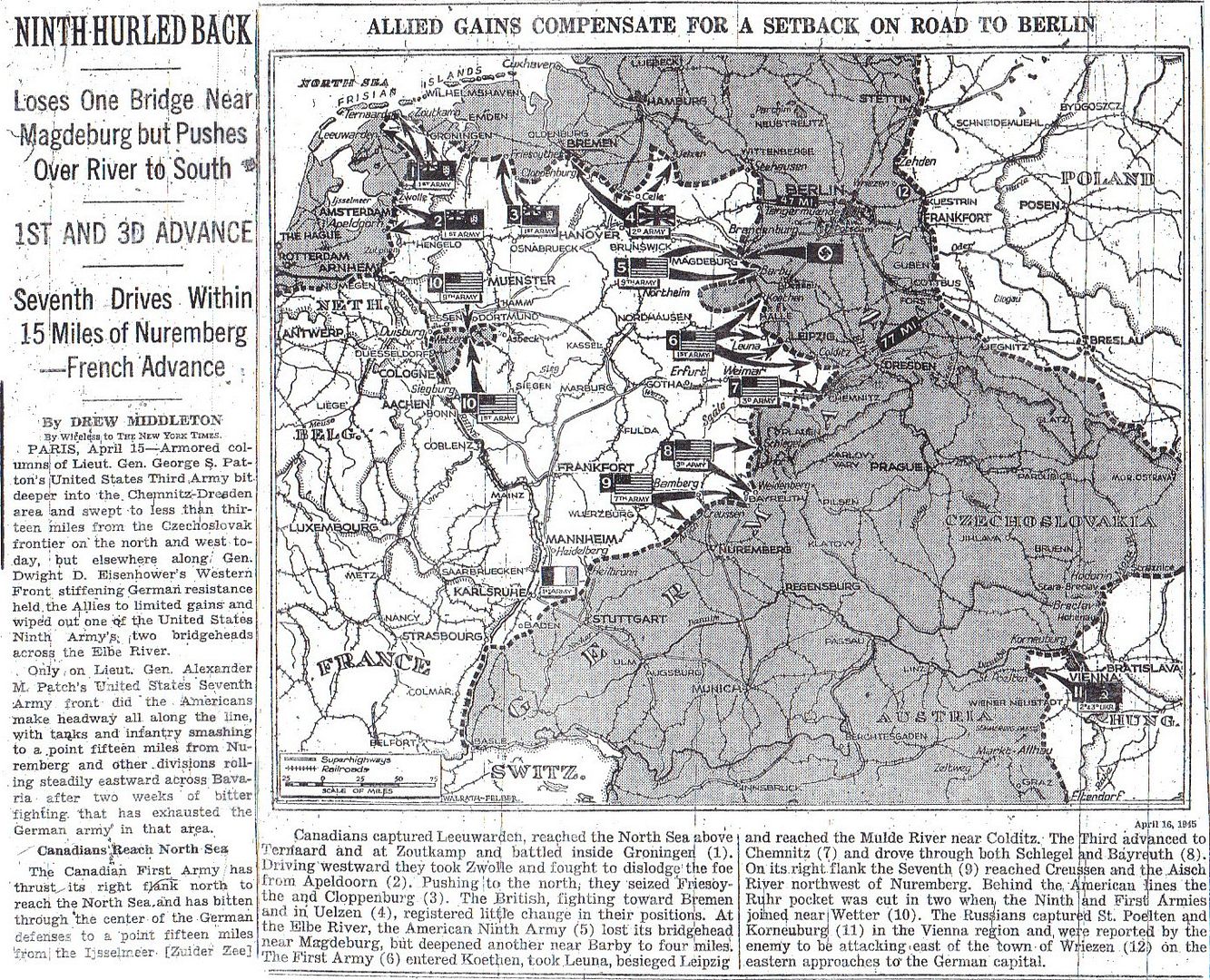
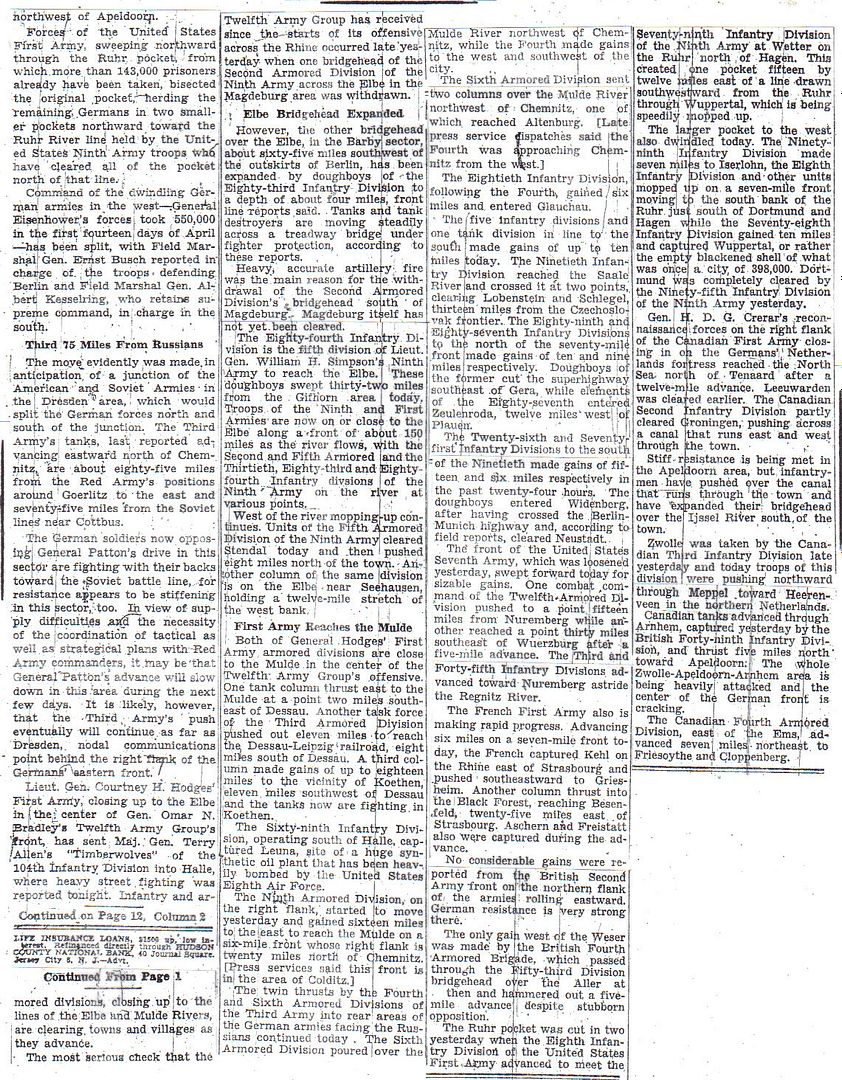
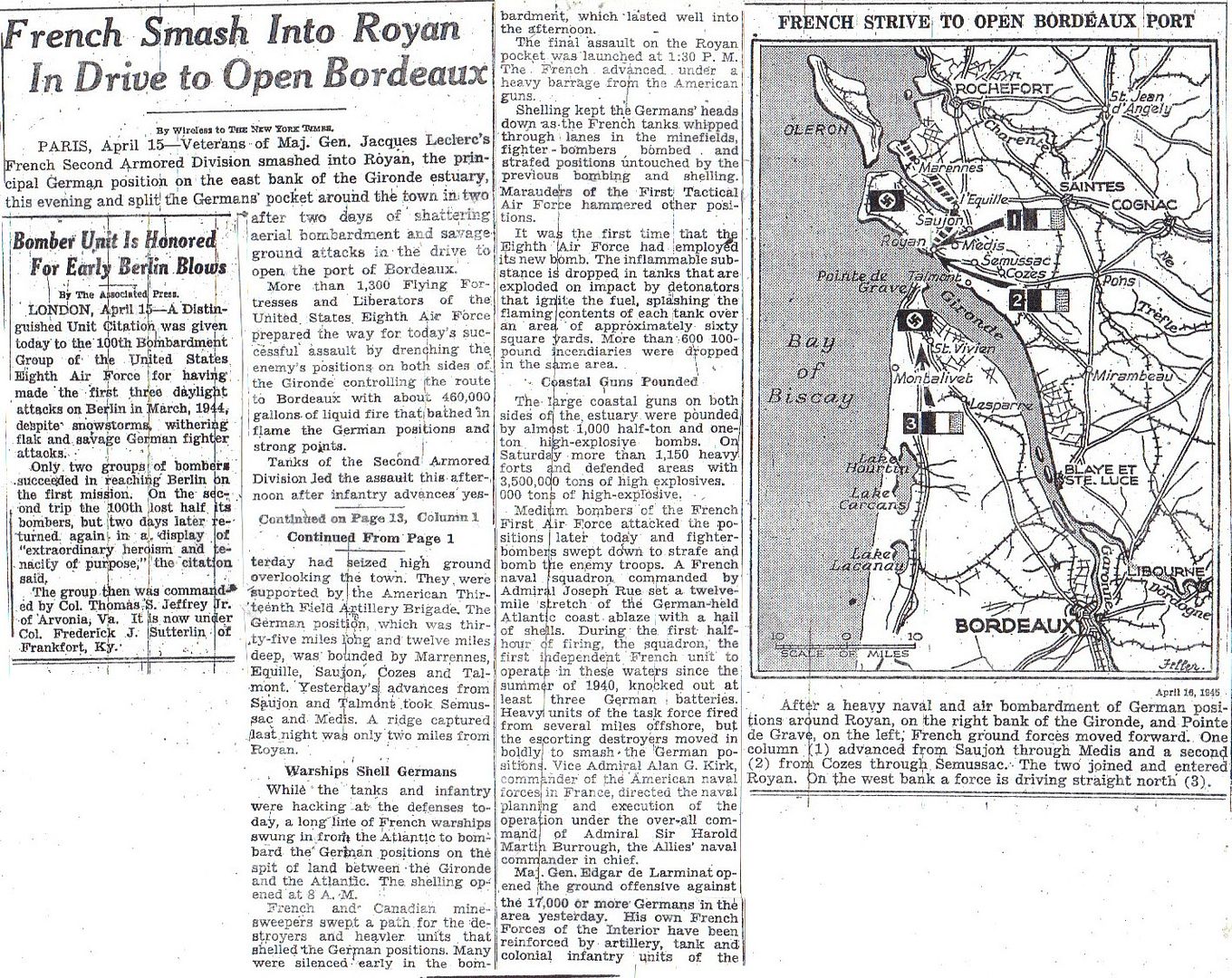
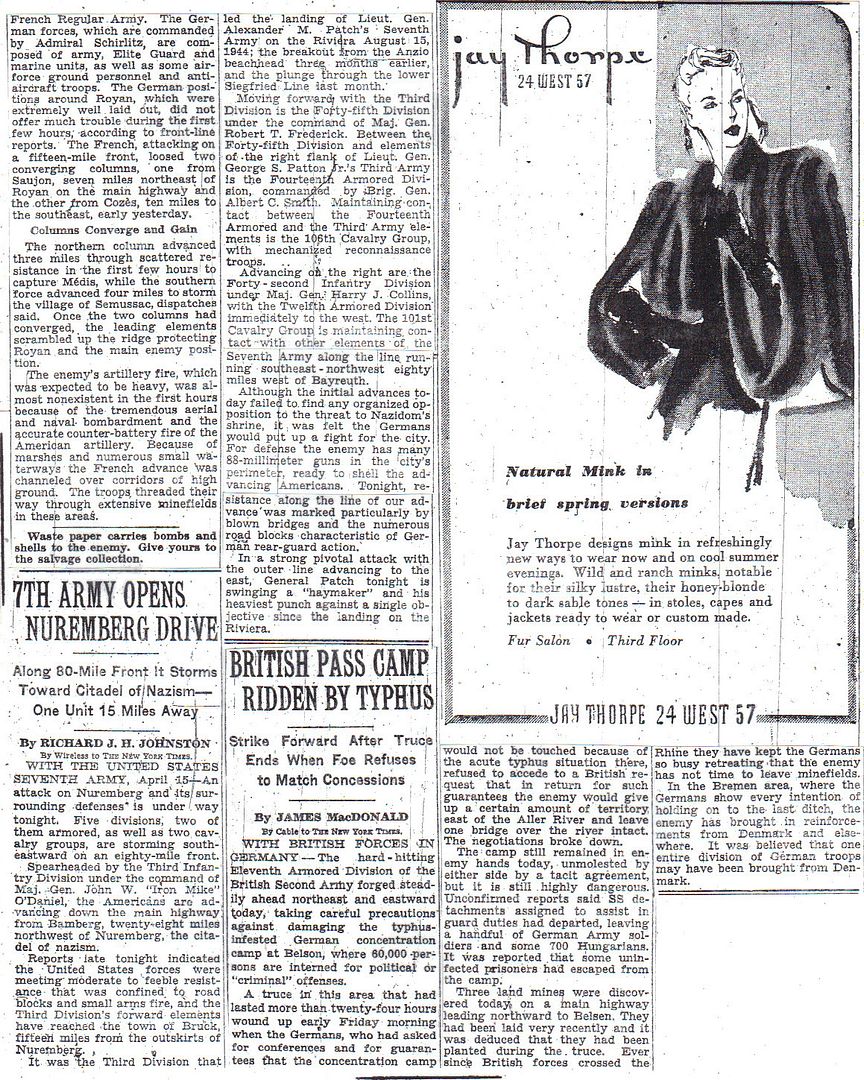
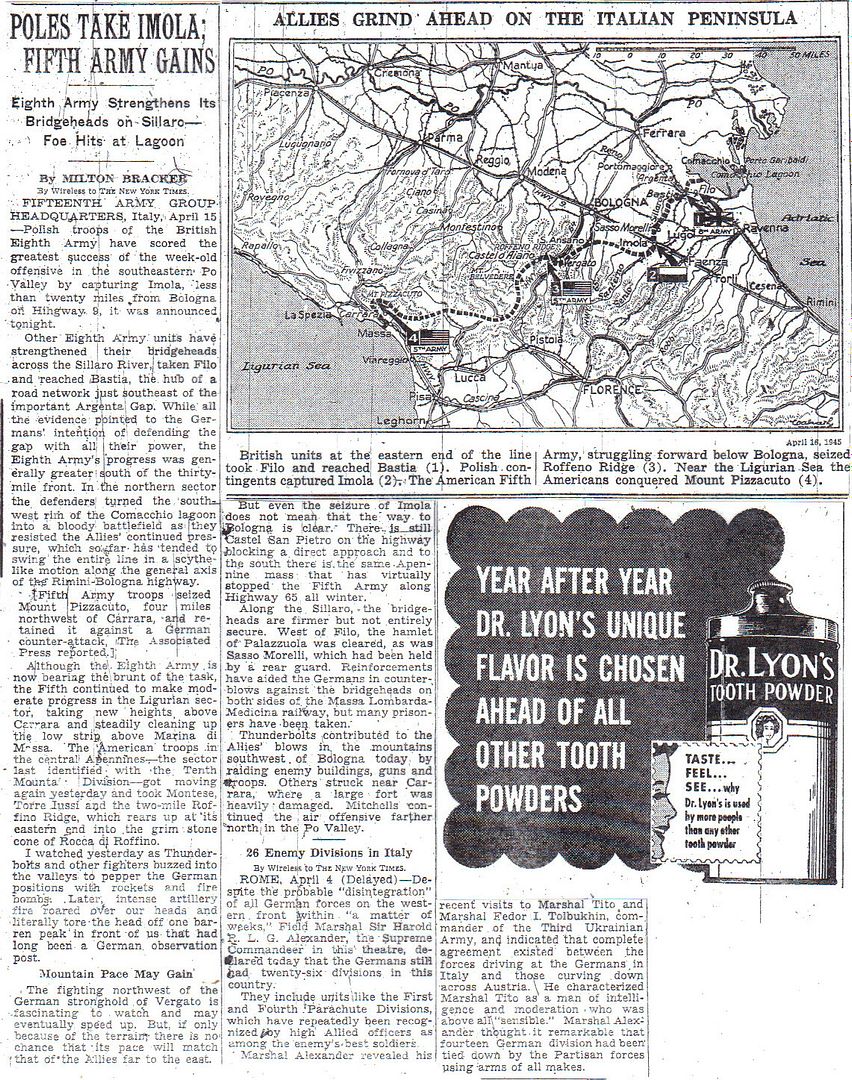
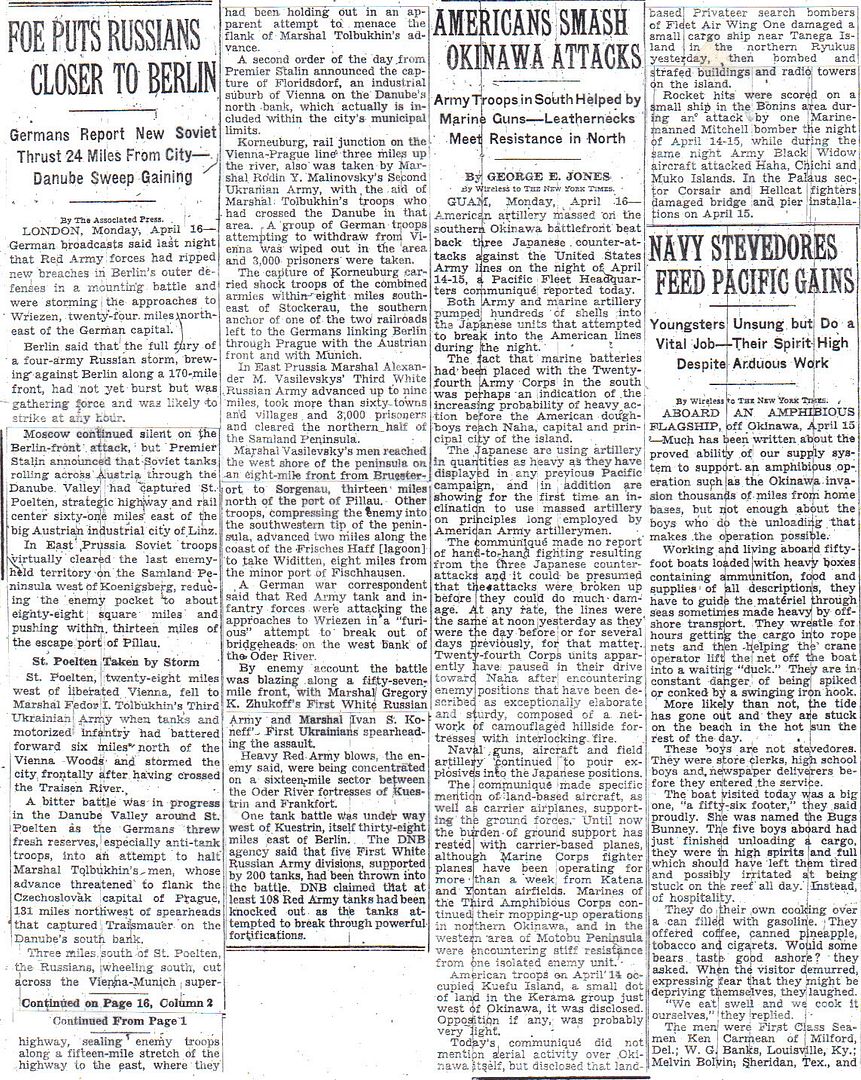
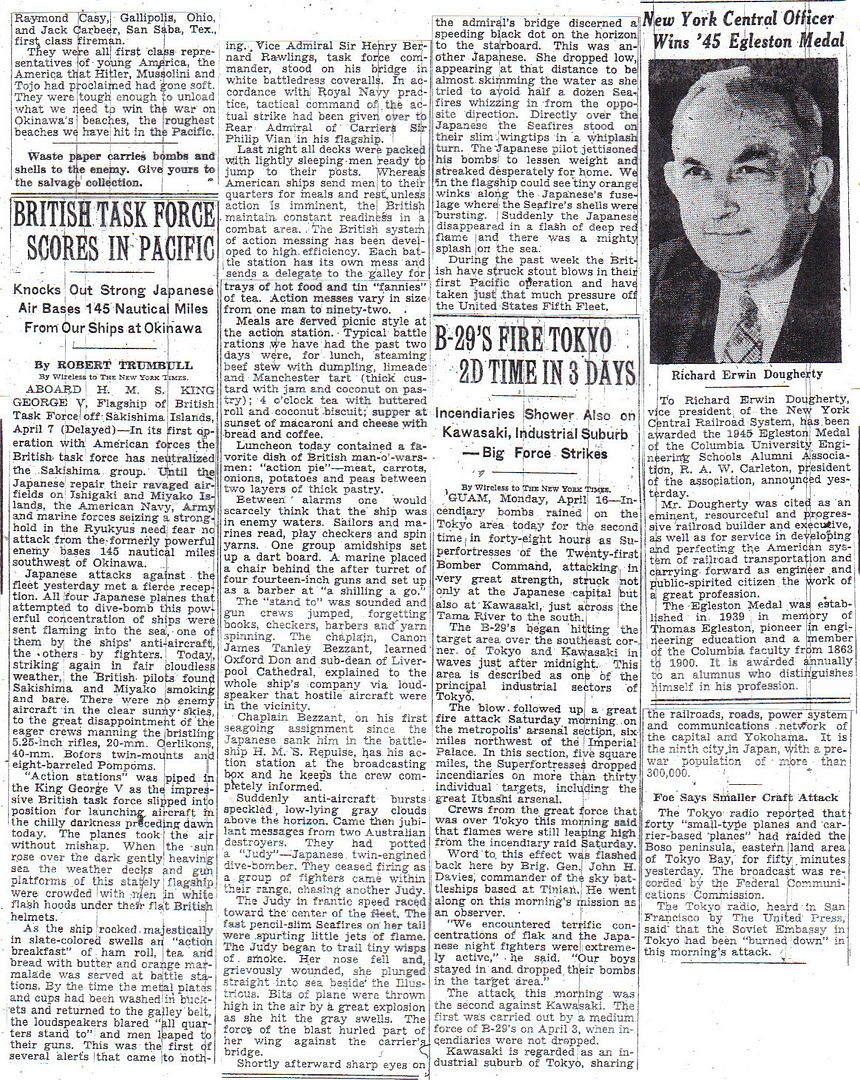
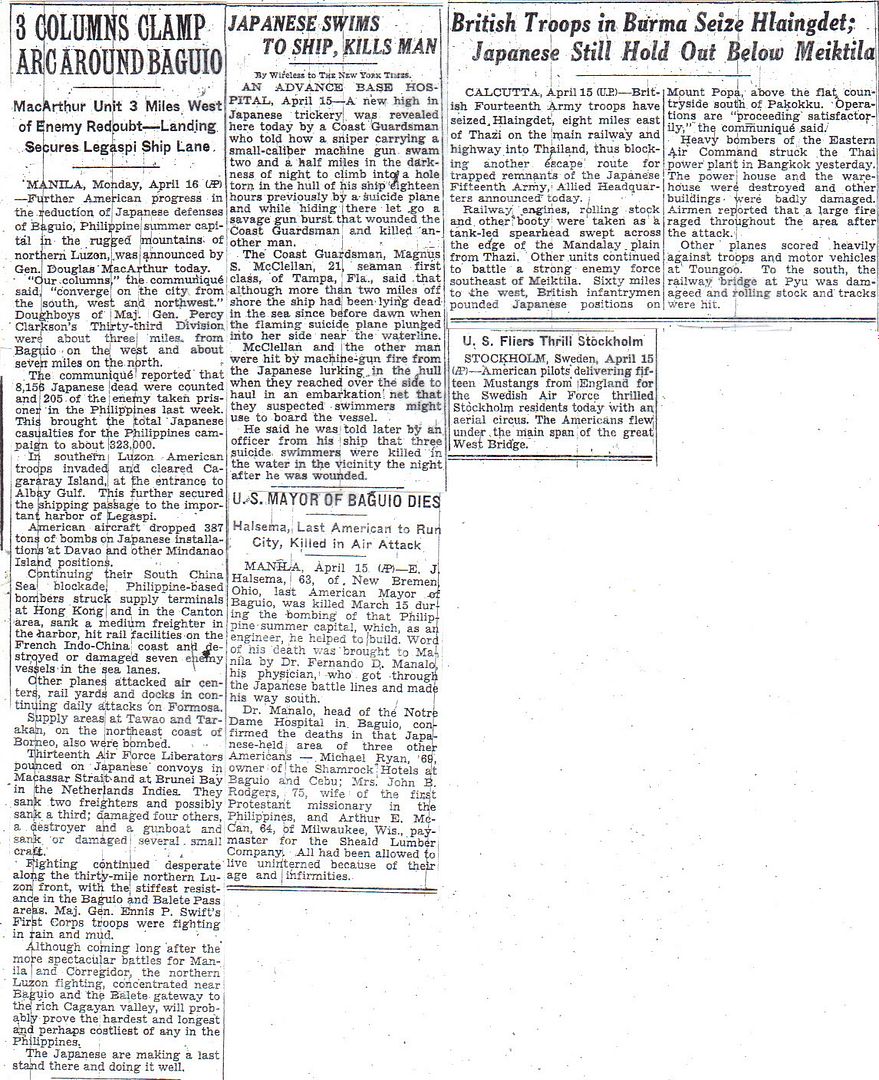
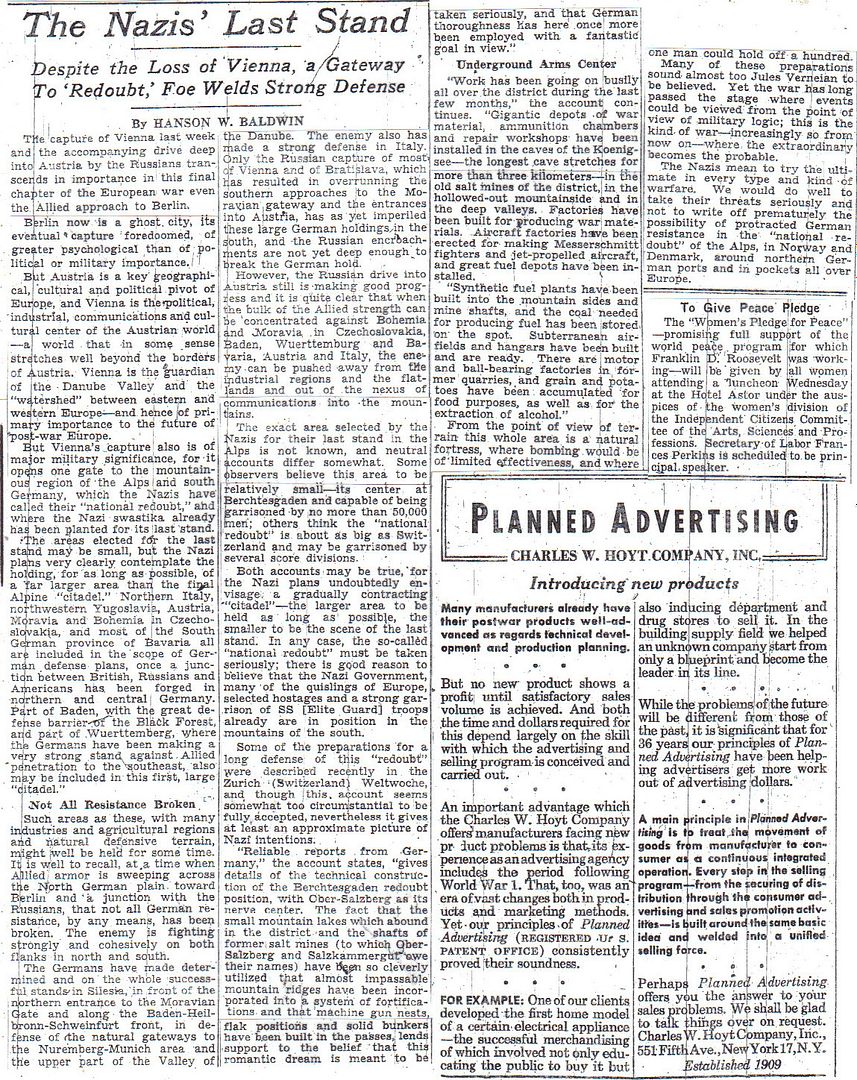
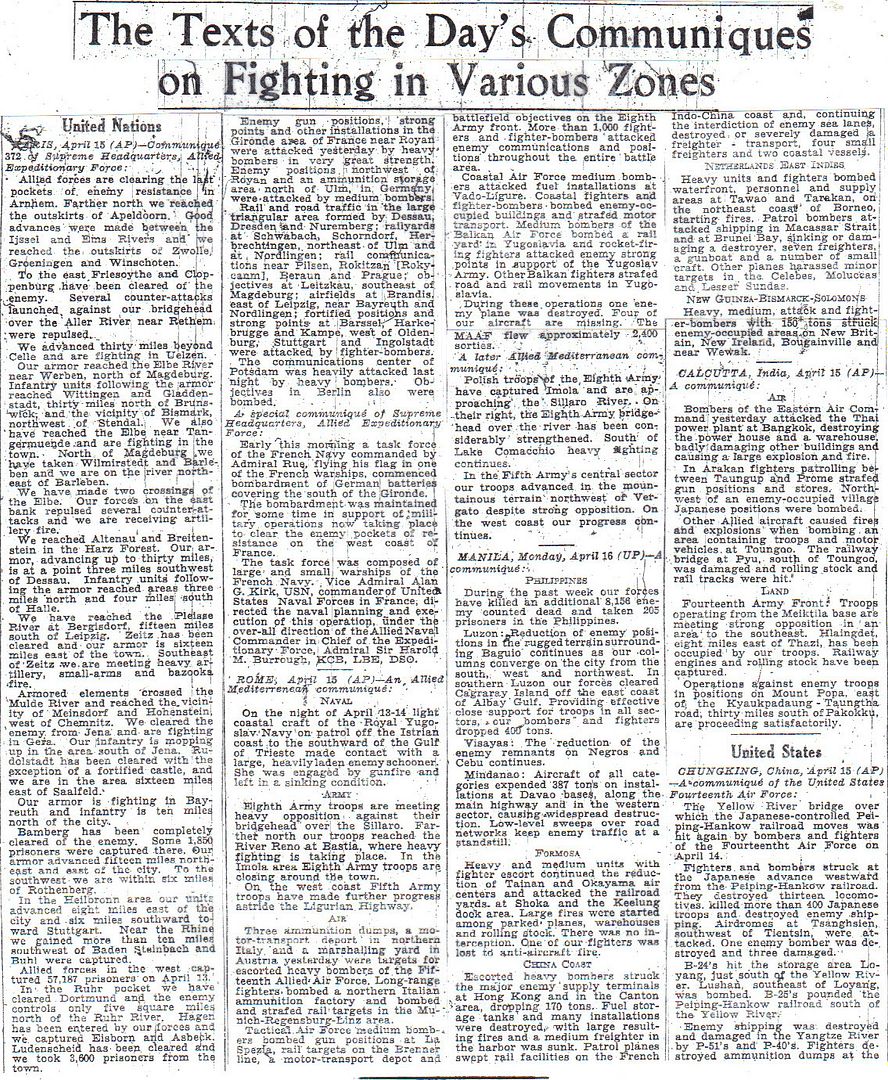
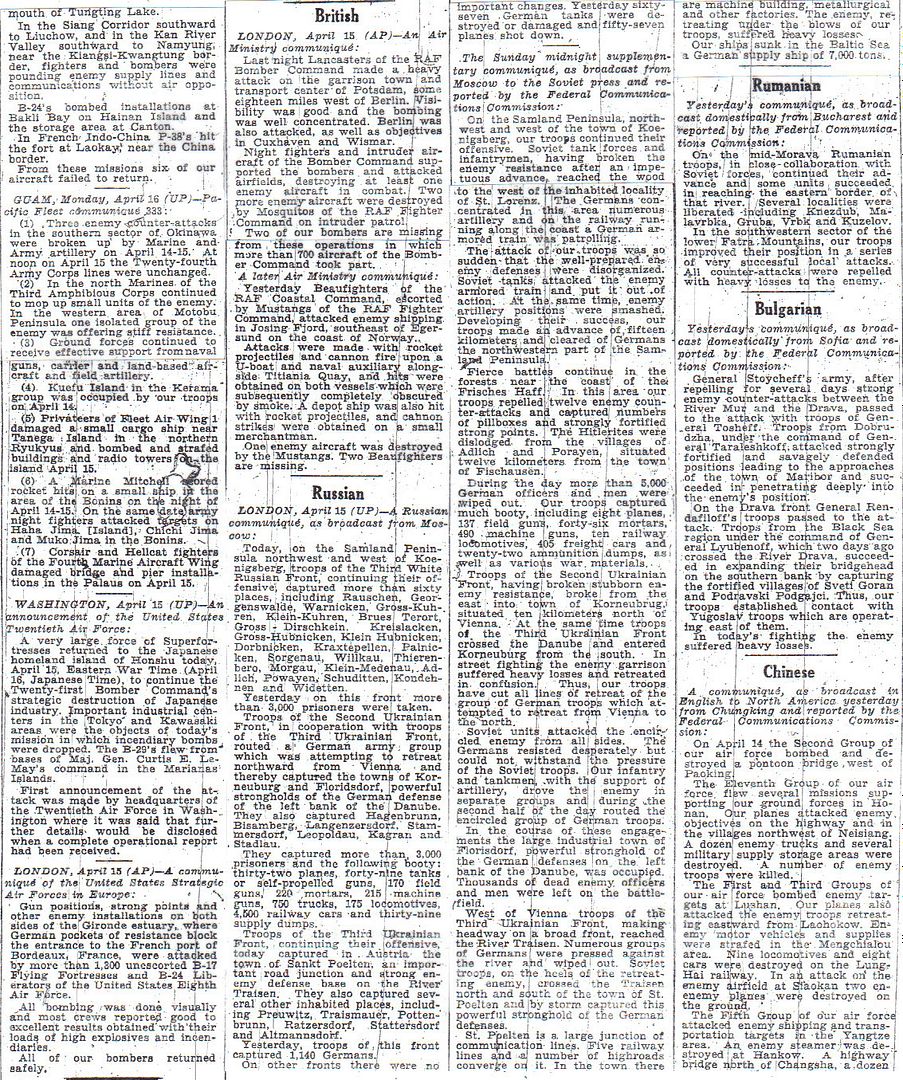

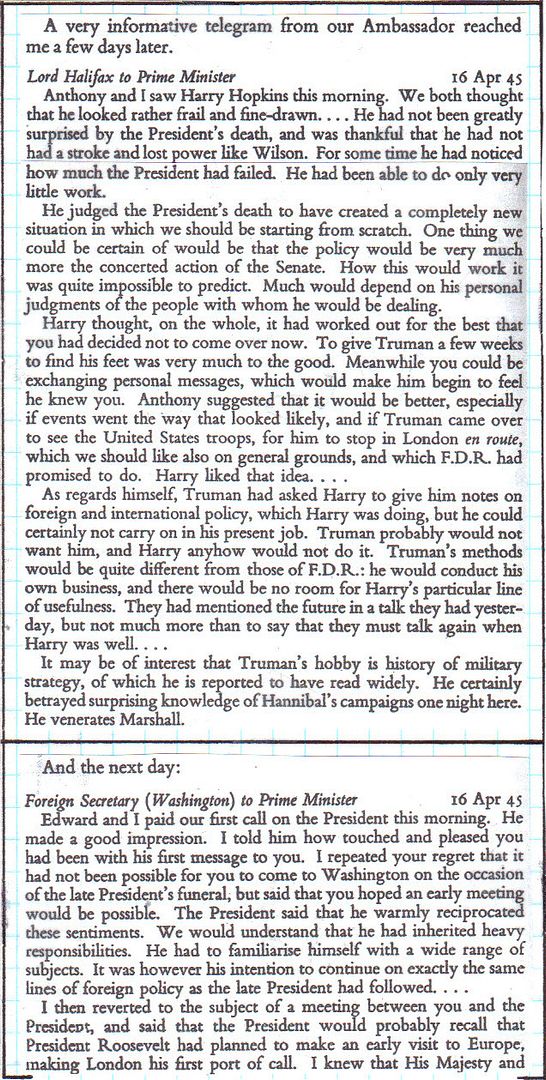
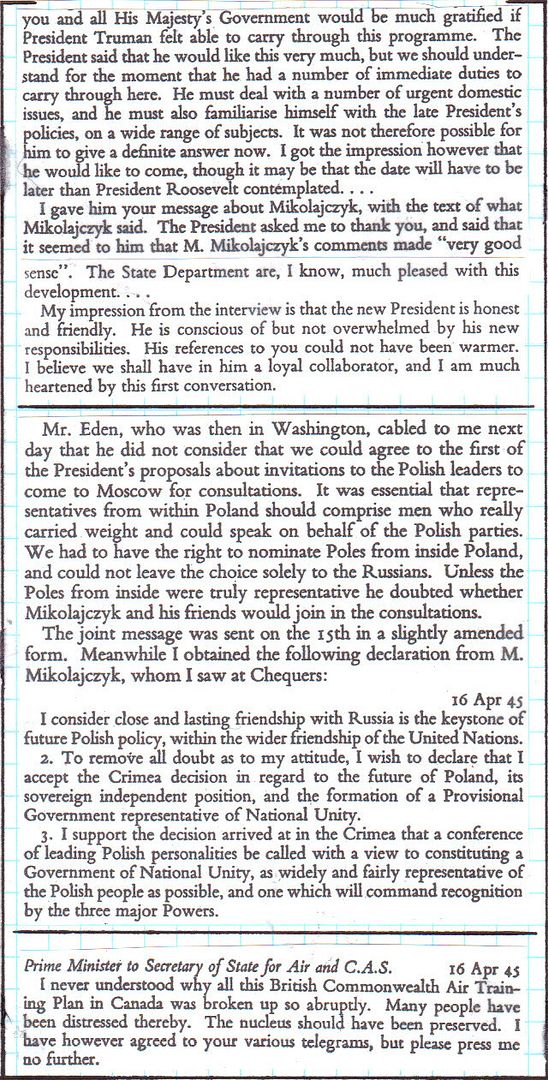
Winston S. Churchill, Triumph and Tragedy
IBTP!
http://www.etherit.co.uk/month/3/16.htm
April 16th, 1945 (MONDAY)
BELGIUM: RAF Meteor III jets make their first operational sortie on the Continent. (22)
FRANCE: The Eighth Air Force flies Mission 951: 1,348 unescorted bombers are dispatched to visually attack strongpoints on the French Atlantic coast; the first two forces below make the sole operational employment of napalm bomb by the Eighth Air Force against German ground installations (pillboxes, gunpits, tank trenches, and heavy gun emplacements); the results are negligible and HQ recommends its discontinuance against this type of target:
- 492 B-17s hit four strongpoints and flak batteries in the Royan area without loss.
- 341 B-24s hit six strongpoints and flak batteries in the Royan area without loss.
- 442 B-17s hit 9 strongpoints and flak batteries in the Bordeaux/Royan, Pointe Grave and Pointe Courbre area without loss.
The Eighth Air Force flies Mission 955: During the morning, 485 B-17s bomb the tank ditch defence line at Pointe de Grave on the south side of the Gironde estuary in the Bordeaux area in support of the ground assault in that area.
GERMANY: The final great offensive of the Red Army against Germany, the Berlin operation begins with Gen. G.K. Zhukov’s 1st Belorussian Front attacking west of the Oder near Kuestrin, and Gen. Konev’s 1st Ukrainian Front attacking south across the Neisse to envelop Busse’s 9th Army and drive on to the southern flanks of the doomed German capital. The Russians meet initial stiff resistance at the Seelow Heights, a fortified defensive position which dominates the flood-plain of the Oder (Oderbruch), and controls access to the main land route to Berlin.
At 4am today, Marshal G. K. Zhukov looked towards Berlin from his bunker in the Kustrin bridgehead over the Oder and ordered: “Now, comrades! Now!” Three red flares floated above the lines and, instantly, the German positions were lit up with the blinding light of 143 searchlights and thousands of tank and lorry headlights. Three green flares soared into the sky. This was the signal for thousands of big guns, wheel to wheel, to open the heaviest barrage of the whole of the war in the east. Villages were blown away. Forests burst into flames, burning fiercely out of control.
The Russians have assembled 2,500,000 men, 6,250 tanks, 41,600 guns and mortars, 3,255 rocket launchers and 7,500 aircraft in three front under Zhukov, Konev and Rokossovsky, for this final assault. It seemed this morning that nothing could stand against this awesome power. Much of that ground was empty, however, for General Heinrici, commanding Army Group Vistula with orders to save Berlin, had withdrawn his men to a second line of defence.
They are fighting now from well-entrenched positions on the Seelow Heights where Flak guns, moved from defending Berlin against Allied bombers have taken a terrible toll of Zhukov’s tanks. He is held up, but Konev’s First Ukrainian Front to the south has made rapid progress after crossing the Neisse. And Rokossovsky to the north has yet to join the battle.
Berlin: Eva Braun has arrived in Berlin from Berchtesgaden to join Hitler in his bunker to share the last days of the Third Reich with him. When the Führer told her that she should have stayed in Bavaria, she said that she had desire to live in a Germany without him. “It would not be fit for a true German,” she says. Eva, the secret mistress of the Nazi leader for more than 12 years, has spent the war in Hitler’s mountain retreat, swimming and skiing, reading cheap love stories and watching romantic movies.
Albert Speer, Hitler’s armaments minister, has been horrified by the directive from the Führer that all military, transport and industrial installations must be destroyed in order to deny them to the enemy. He has protested vigorously, but Hitler remains adamant. If the war is lost, he told Speer, there will be no point in attempting to save the German people. Speer, however, is co-operating with army officers to frustrate the Führer’s directive.
Hitler sees betrayal everywhere. Today he sacked the Reich public health commissioner, Karl Brandt, after learning that Brandt had sent his wife and child to Thuringia so that they could surrender to the Americans. And as the Red Army opens its final assault on Berlin, Hitler, in his bunker beneath the ruins of his Chancellery, issued an order of the day to his broken army: “He who gives the order to retreat is to be shot on the spot.”
The US 7th Army reaches Nürnburg.
The Colditz POW camp is liberated by US troops, liberating 19,000 prisoners.
USAAF, 78th Fighter Group is awarded a Distinguished Unit Citation for its actions today destroying 135 aircraft on five airfields near Prague and Pilzen, Czechoslovakia.
RAF Mustang IV fighters of No. 611 Squadron are the first RAF aircraft to greet Russian aircraft over Berlin.
258 Ninth Air Force B-26s and A-26 Invaders bomb marshalling yards at Gunzburg and Ulm (primary targets) and several other targets including 3 marshalling yards; fighters escort the bombers, fly patrols and armed reconnaissance, and support the US 3d Armored Division near Dessau and across the Mulde River near Torten, the 9th Armored Division along the Mulde northwest of Borna, the VIII Corps along Weisse Elster River between Gera and Plauen, the XX Corps astride the Mulde NE of Chemnitz (where the 6th Armored Division awaits Red Army forces), and the 2d Armored Division on the Elbe River near Magdeburg.
The Eighth Air Force flies Mission 954: In the afternoon, 1,252 bombers and 913 fighters are dispatched to attack rail targets; they claim 727-0-373 Luftwaffe aircraft; 1 B-24 and 31 fighters are lost.
- 273 B-24s bomb the marshalling yard at Landshut; a B-24 is lost. Escorting are 299 P-47s and P-51s; they claim 228-0-109 aircraft on the ground; a P-47 and 16 P-51s are lost.
- 148 B-17s bomb the Regensburg marshalling yard, 72 bomb the Regensburg East rail bridge and 74 bomb the Regensburg West rail bridge; 77 hit the Platting marshalling yard; and 76 attack the rail bridge at Straubing. The escort is 240 P-51s; they claim 2-0-0 aircraft in the air and 86-0-66 on the ground; 3 P-51s are lost.
- 286 P-51s fly a freelance mission in support of the bombers attacking 40+ landing grounds in Germany and Czechoslovakia; they claim 1-0-1 aircraft in the air and 410-0-198 on the ground; 9 P-51s are lost.
About 450 Ninth Air Force A-20s, A-26 Invaders and B-26s bomb the Zerbst communications centre, Gunzenhausen marshalling yard, Kempten ordnance depot, and Wittenberg marshalling yard and gun positions; the IX Tactical Air Command’s fighters claim 25 air victories during the day as they escort the bombers, fly patrols, area cover, and armed reconnaissance, attack airfields and other targets, and support the US 3rd Armored Division southwest of Dessau, the 9th Armored Division in the Bennewitz-Colditz area along the Mulde River, the XX Corps which remains at the Zwickauer Mulde River bridgehead northeast of Chemnitz, the VIII Corps crossing the Weisse Elster River between Gera and Plauen, the 2d Armored Division on the Elbe River near Magdeburg, the XIX Corps east of Barby, and the V Corps near Leipzig.
36 Fifteenth Air Force P-51s sweep areas south of Munich; Pie, Czechoslovakia; and Linz, Austria, and 4 strafe an airfield east of Munich.
BALTIC SEA: The Goya (5,200 ton GRT transport formerly of the Hamburg-Amerika line), another German ship similar to the Wilhelm Gustloff (see January 30, 1945), is sunk in the Baltic by the Soviet submarine L-3 commanded by Captain Vladimir Konovalov, taking with it 6,220 refugees, making these two ships the worst naval disasters of all time. Captain Konovalov is later awarded the order of “Hero of the Soviet Union” for this.
The GOYA put out from the Hela Peninsula (Danzig-Gotenhafen) on April 16, 1945 packed with c. 6000 evacuees of wounded soldiers and refugee civilians when it was suddenly torpedoed with two direct hits amidships which broke it in two, and it sank in an estimated 4 minutes in the cold dark seas of the Baltic. Only 183 passengers were rescued from this disaster, many of which later died from exposure. The sinking of the GOYA is the second greatest maritime disaster in history. The first of course, by numbers alone, is the Wilhelm Gustloff. On February 10, 1945, the GENERAL VON STEUBEN, another transport of wounded and refugees was also sunk (in seven minutes) by the same Soviet sub (S13) which sank the GUSTLOFF — some 3000 souls were lost in that event. (Russell Folsom)
The RAF sink the LUTZOW, Germany’s last pocket battleship.
ITALY: During the night of 14/15 April, Twelfth Air Force A-20s and A-26s concentrate on communications targets in the Po Valley, particularly the Po River crossings, the towns of Vignola, Zoeca and Sass, and several targets of opportunity; during the day B-25s and B-26s and fighter-bombers concentrate on direct support of the US Fifth and British Eighth Armies drives, hitting troop concentrations south of Portomaggiore, guns, strongpoints, and a variety of targets in areas south of Bologna, around Medicina and Sasso Marconi and at other points in battle areas.
830 Fifteenth Air Force B-17s and B-24s, in support of the US Fifth Army, blast gun positions, supply dumps, troop concentrations, maintenance installations, and German HQ along highways leading from Bologna; 145 P-38s furnish escort; another force of 312 B-17s and B-24s bomb rail diversion bridges at Nervesa della Battaglia, Ponte di Piave, and Casarsa della Delizia, and an ammunition factory and stores at Ghedi; 191 P-51s provide escort. Today’s effort is the largest of World War II by the Fifteenth Air Force (most fighters and bombers dispatched and attacking, and the largest bomb tonnage dropped) during a 24-hour period; 1,142 heavy bombers bomb targets.
98 Fifteenth Air Force B-24s, escorted by 102 P-51s, bomb positions southwest of Bologna; almost 700 B-24s and B-17s abort due to bad weather.
CENTRAL EUROPE: The Fifteenth Air Force dispatches 36 P-38s and 36 P-51s strafe rail communications in the area bounded by Munich, Germany, Salzburg and Linz, Austria, Plzen, Czechoslovakia, and Regensburg, Germany; 12 of the P-38s skipbomb rail targets in the Salzburg-Linz, Austria area, including the Vocklabruck marshalling yard; 8 P-38s furnish top cover for the strafing missions.
CHINA: 3 Fourteenth Air Force B-25s knock out the Pa-Ching pontoon bridge, 7 attack a storage depot at Fang-cheng, 4 bomb Tunganhsien, and 3 hit Paoching; 1 B-24 bombs the Canton docks; almost 200 fighter-bombers ranging over all of southern China and up into the northern China plain hit numerous targets including bridges, river shipping, town areas, trucks, railroad traffic, gun positions, storage areas, and general targets of opportunity; the Paoching, Hengyang, Yungfengshih, and Hsihhsiassuchi areas are especially hard hit.
18 Fourteenth Air Force B-24s pound a storage area at Linfen; 3 bomb targets of opportunity in the Bakli Bay, Hainan Island and Canton areas; 10 B-25s bomb Yungfengshih, Kweilin, and Shanhsien, knocking out a bridge and hitting buildings, river shipping, and rail traffic. About 120 fighter-bombers over southern and eastern China hit river, road, and rail traffic, town areas, troops, and general targets of opportunity at many scattered locations.
BURMA: Allied advances are continuing in Burma, with the capital, Rangoon, now firmly in General Slim’s sights. Today it was the turn of Taungup, in the Arakan peninsula, to fall to XV Corps, while inland IV Corps is chasing General Honda’s 33rd Japanese Army down the Sittang valley towards Pyinmanna. The Japanese forces are also in retreat along the Irrawaddy, where XXXIII Corps is driving south to oil-rich Yenangyaung.
62 Tenth Air Force) P-38s and P-47s attack troop concentrations and supply areas at Loi-Mwe, Lawksawk, Thongdan, and near Laihka; 312 transport sorties are flown to forward areas.
22 Tenth Air Force fighter-bombers attack troop concentrations in the Ke-hsi Mansam vicinity; 19 others attack road bridges behind enemy lines, claiming a bridge destroyed; air transport operations to forward areas continue on steady basis.
FORMOSA: Far East Air Forces B-24s bomb Toyohara, Shinchiku, and Shinshoshi Airfields and B-25s hit the Shoka rail yards.
Far East Air Forces B-25s hit Taien Airfield, while B-24s and P-51s bomb Giran and Matsuyama Airfields and nearby areas. During the night of 15/16 April, B-24s bomb Taihoku.
COMMONWEALTH OF THE PHILIPPINES: Ft. Frank, a “concrete battleship”, in Manila Bay is attacked with fuel oil and allowed to burn. Ft. Drum had been similarly attacked on the 14th. This completes the capture of Japanese positions in Manila Bay.
US forces invade Carabao after two days of intensive shelling, only to find that the Japanese are long gone.
A battalion of the 151st Infantry Regiment, 38th Infantry Division, lands on Carabao Island at the entrance to Manila Bay; landing is preceded by cruiser/destroyer and aircraft bombardment.
Far East Air Forces B-24s and fighter-bombers bomb island fortifications in Manila Bay, fighter-bombers hit bivouacs and other targets in northern Luzon and support ground forces east of Manila and on Carabao Island. Fighter bombers and B-24s fly support missions for ground forces on Negros and Cebu Islands. On Mindanao Island, B-24s bomb the Davao area and B-25s join USMC F4U Corsairs and SBD Dauntlesses in hitting highways and vehicles.
The 1st Battalion, 151st Infantry Regiment, 38th Infantry Division, makes an unopposed landing on Carabao Island in Manila Bay. The landing had been supported by the light cruiser USS Phoenix (CL-46), two destroyers and two infantry landing craft (rocket) [LCI(R)s]. The Phoenix had blown a hole in the seawall and the only thing encountered by the soldiers was “one badly shaken pig.”
JAPAN: The U.S. Army’s 77th Infantry Division, less the 307th Infantry Regiment, lands on the south and southwest coast of Ie Shima, Ryukyu Islands. The island of Ie Shima is located off the northwest coast of Okinawa at 26.43N, 127.47E.
RYUKYU ISLANDS: Off Okinawa, kamikazes sink destroyer USS Pringle (DD-477); and damage battleship USS Missouri (BB-63); aircraft carrier USS Intrepid (CV-11); destroyer USS Bryant (DD-665); destroyer escort USS Bowers (DE-637); high speed minesweepers USS Hobson (DMS-26) and USS Harding (DMS-28); and oiler USS Taluga (AO-62).
Aircraft of fast carrier task force (Vice Admiral Marc A. Mitscher) attack airfields and aircraft on the ground in southern Kyushu Island; the strike is repeated on 16 April.
During the night of 15/16 April, the Twentieth Air Force flies two missions: (1) Mission 68: 194 B-29 Superfortresses bomb the Kawasaki urban area while 8 others hit targets of opportunity; 12 B-29s are lost. (2) Mission 69: 109 B-29s hit the urban area of Tokyo; 1 B-29 is lost.
In the Kurile Islands, Eleventh Air Force B-25s abort a mission to bomb Hayakegawa because of weather front; 6 B-24s radar bomb the Kataoka naval base on Shimushu Island; another B-24 flies a radar-ferret sortie.
The VII Fighter Command flies Mission 3: In the first very long range fighter operation from Iwo Jima, P-51s with XXI Bomber Command B-29 Superfortress navigational escorts, strafe and bomb targets at Kanoya Airfield on Kyushu Island; 4 P-51s are lost; B-29s continue to furnish navigational escort in all subsequent VII Fighter Command strikes (through 14 August) on Japan from Iwo Jima.
BORNEO: Far East Air Force P-38s attack the Lingkas Tank Farm and other targets at Tarakan.
PACIFIC OCEAN: Submarine USS Charr (SS-328) lays mines off the Malay Peninsula. Two Japanese ships are sunk. (1) A guardboat is sunk by U.S. aircraft off Chezhudo, Korea and (2) a mine laid by USAAF B-29 Superfortresses sinks a cargo ship southeast of Hesaki Light, Japan.
18 Guam-based Seventh Air Force B-24s bomb Marcus Island in the North Pacific.
Japanese ships sunk at sea:
- Submarine USS Sea Dog (SS-401) sinks a merchant cargo ship off Mikura Jima.
- Submarine USS Sunfish (SS-281) attacks a convoy emerging from Yamado harbour, Honshu, and sinks a coast defence vessel and a transport.
MARIANA ISLANDS: 2 Seventh Air Force P-61 Black Widows from Saipan bomb and strafe Pagan Island.
VOLCANO ISLANDS: Iwo Jima is declared secure.
Centre Field (Motoyama Airfield No. 2 to the Japanese) is declared operational. The airfield will be used by damaged B-29s returning from missions to Japan.
U.S.A.:
In his first speech to Congress, President Harry S. Truman pledged to carry out the war and peace policies of his late predecessor, President Franklin D. Roosevelt. (Tony Giuliani)
Top popular hits on the music charts are “My Dreams are Getting Better All the Time” by The Pied Pipers; “I’m Beginning to See the Light” by Harry James and his Orchestra with vocal by Kitty Kallen; “Candy” by Johnny Mercer and Jo Stafford; and “Smoke on the Water” by Bob Wills and his Texas Playboys.
The federal government tacked another year on to the term of one of Roosevelt’s key pieces of wartime legislation, the Lend-Lease Act. All told, the U.S. funnelled US$50.6 billion (US$496 in year 2001 dollars) worth of Lend-Lease aid to the Allies during the war, the majority of which went to Britain and the USSR.
ATLANTIC OCEAN: The German submarine U-1235 is sunk in the North Atlantic by destroyer escorts USS Frost (DE-144) and USS Stanton (DE-247). All 57 crewmen on the U-boat are lost.
German submarine U-880 is sunk in the North Atlantic by depth charges from the destroyer escorts USS Frost (DE-144) and USS Stanton (DE-247). All 49 crewmen on the U-boat are lost.
Minesweeper HMCS Esquimalt is attacked and sunk by U-190 (Oberleutnant Hans-Edwin Reith) off Halifax, Nova Scotia at 44 28N 63 10W. There are 44 casualties.
Frigate HMS Ekins strikes a mine at 2115 which causes her boiler room to flood, and she lies dead in the water. At 2140 she drifts onto another mine and this causes further flooding. The ship’s company are able to get the ship moving again, and she returns to the Medway under her own power, but after survey is paid off and not repaired. Location: 24 miles NW Ostend. (Alex Gordon)(108)
"U.S. troops discovered these charred bodies when they entered the camp at Thekla, Germany.
Margaret Bourke-White, a correspondent for Life magazine, described one of the corpses, that of a professor from Poland, with these words:
'The shriveled lower half of his body lay in cinders...with his charred crutch close by, but the fine intellectual bald head thrust through to the outside [of the camp's fence] was still unmarred, with even the spectacles in place.
He must have been much loved; the survivors shed many tears over him.' "
"Most smaller camps employed diesel-powered engines to create the gas used to murder their victims, but the Nazis often improvised (above) to carry out their grisly tasks."
"The Allies' liberation of the disease-infested and horribly overcrowded concentration camps in Germany was a bittersweet experience.
For African-American soldiers, seeing victims of racism--dead, dying, or suffering--was a frightening reminder of the potential consequences of prejudice.
"While nothing could have prepared anyone for what lay behind the gates of Dachau and Buchenwald, African-American soldiers seemed particularly affected by what they witnessed.
Bob Bender, a survivor liberated from Buchenwald, recalls the 'black soldiers of the U.S. Third Army, tall and strong, crying like babies, carrying the emaciated bodies of the liberated prisoners.'
"Awestruck by what he had seen at Buchenwald, Leon Bass of the 183rd Combat Engineer Battalion of the U.S. Third Army offered this powerful observation: 'I came into that camp an angry black soldier.
Angry at my country and justifiably so.
Angry because they were treating me as though I was not good enough.
But [that day] I came to the realization that human suffering is not relegated to me and mine.
I now knew that human suffering could touch us all....[What I saw] in Buchenwald was the face of evil...it was racism.' "
Along the 9th Army Front, the Germans are holding their main defensive line along the Seelöwe Heights west of the Oder. This is the last time a German defensive system will hold back a major Soviet assault for any period of time.
In the north, the Germans helplessly watch the Soviets finish their preparations. The only thing holding them back is the flooded Oder, which will recede in a few days.
The next map will not be available until this Sunday, April 19.
http://www.eyewitnesstohistory.com/berlin.htm
The Battle of Berlin, 1945
The final chapter in the destruction of Hitler’s Third Reich began on April 16, 1945 when Stalin unleashed the brutal power of 20 armies, 6,300 tanks and 8,500 aircraft with the objective of crushing German resistance and capturing Berlin. By prior agreement, the Allied armies (positioned approximately 60 miles to the west) halted their advance on the city in order to give the Soviets a free hand. The depleted German forces put up a stiff defense, initially repelling the attacking Russians, but ultimately succumbing to overwhelming force...
http://en.wikipedia.org/wiki/Battle_of_the_Seelow_Heights
The Battle of the Seelow Heights (German: Schlacht um die Seelower Höhen) was part of the Seelow-Berlin Offensive Operation (16 April-2 May 1945), one of the last assaults on large entrenched defensive positions of World War II. It was fought over three days, from 16–19 April 1945. Close to one million Soviet soldiers of the 1st Belorussian Front (including 78,556 soldiers of the Polish 1st Army), commanded by Marshal Georgi Zhukov, attacked the position known as the “Gates of Berlin”. They were opposed by about 110,000 soldiers of the German 9th Army,[4] commanded by General Theodor Busse, as part of the Army Group Vistula.
This battle is often incorporated into the Battle of the Oder-Neisse. Seelow Heights was where the most bitter fighting in the overall battle took place, but it was only one of several crossing points along the Oder and Neisse rivers where the Soviets attacked. The Battle of the Oder-Neisse was itself only the opening phase of the Battle of Berlin.
The result was the encirclement of the German 9th Army and the Battle of Halbe.
http://www.ihr.org/jhr/v12/v12p371_Ries.html
The sinking of the Goya on April 16, 1945, just three weeks before the end of the war in Europe, is acknowledged as almost certainly the greatest maritime disaster, in terms of lives lost, of all time.
Indeed, when the 5,230-ton transport ship set out from Hela near Danzig (Gdansk) with its human cargo of some 7,000 refugees and wounded soldiers, the Soviets were pressing into Berlin itself, and the Bay of Danzig, with the exception of the narrow Hela peninsula, had become virtually a Soviet lake. In spite of the merciless blows that were bringing Germany to its knees, what was left of its once mighty military continued to evacuate civilian refugees to the west. Under almost constant fire from Soviet artillery, ships, and planes, German authorities were still able to evacuate 264,887 people to relative safety during the month of April 1945. [18]
German ports in the western Baltic were by now so overcrowded with shipping and refugees that when the already badly mauled Goya weighed anchor on its final voyage, it set out with five other ships for the Danish capital of Copenhagen. As the convoy made its way along the treacherous Stolpe Bank, it was spotted by Captain Konovalov, commander of the minelayer submarine L-3. Considered to be the most successful submarine in the entire Soviet fleet, the L-3 was credited with sinking four ships in 1941, six in 1942, and three in 1943, including U-boat U-416, by mining. [19]
At precisely four minutes to midnight, the L-3 fired two torpedoes at the Goya, which found their marks amidship and stern. Almost immediately the ship broke in half, her masts crashing down upon the passengers crowding the decks. Before anyone could escape from the holds, the onrushing sea quickly drowned out the anguished screams of the refugees below. The vessel sank in just four minutes, resulting in the loss of almost 7,000 lives. There were only 183 survivors. [20]
“The special tragedy of the Goya,” American historian Alfred de Zayas has commented, “was that it happened so close to the of the war, at a time when the German surrender was within grasp.” These deaths failed to hasten the end of the war in any way. At a time when the Soviets had already begun the actual expulsion of Germans from the entire Baltic region, he asked rhetorically, “Why then send so many thousands of refugees to the bottom of the sea?” [21]
At the time, the loss of the Goya was hardly noticed in Germany, which had grown accustomed to similar catastrophes on a daily basis. All the same, it was cited in the report of the Führer Naval Conference of April 18, the last conference of which there is any archival record. It is written in language that characterized the cool professionalism that the German Naval High Command had shown throughout the entire period of the evacuation: [22]
“In connection with the loss of several hundred persons in the sinking of the steamship Goya, the Commander-in-Chief of the Navy points out that personnel losses in the transports in the Eastern areas up to this time have been extremely small, that is, 0.49 percent. These unfortunate losses seem very large every time a ship is sunk, and it is easy to forget that at the time a large number of ships with numerous wounded and refugees reach port safely.”
Although the estimate of losses given here is understated, the mass evacuation operation did, indeed, prove to be an overall success. Under terrible conditions, the German navy and merchant marine succeeded in saving many hundreds of thousands of civilians from horrible mistreatment and almost certain death at Soviet hands.
President Harry Truman addresses a joint session of the Congress of United States - April 16, 1945
Footage:
https://www.youtube.com/watch?v=DTTWXEUhINg
Much better full audio of the Truman speech to Congress:
https://www.youtube.com/watch?v=t4qlV5UsWJY
“Our demand has been, and it remains, UNCONDITIONAL SURRENDER!”
— President Harry Truman, April 16, 1945
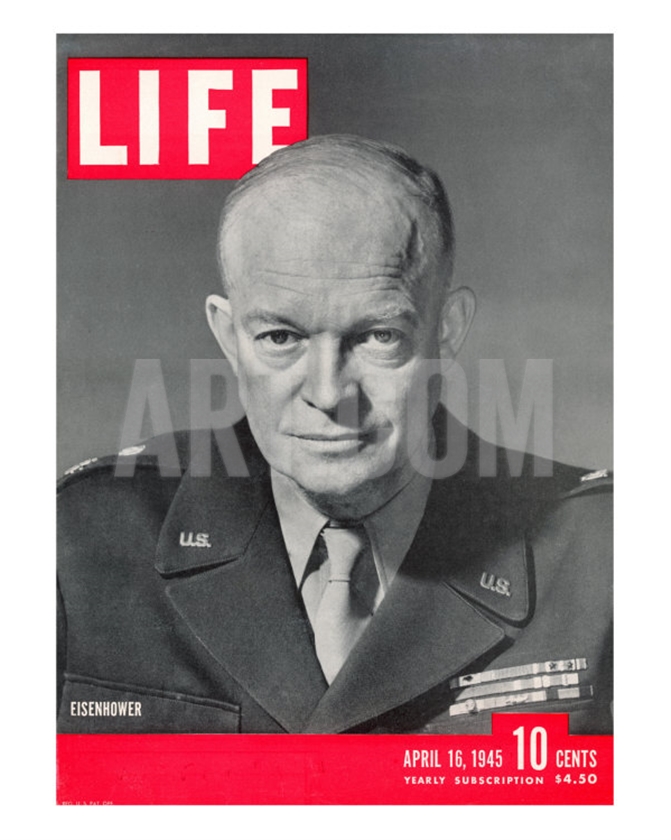
April 17
On 14 April I rejoined the 232 Regimental advance command post. For anyone interested. The City of Schweinfurt has a site of pictures called the Third Reich in Ruins, including Schweinfurt. Very good before and after pictures of war at http://www.thirdreichruins.com/schweinfurt5.htm
Disclaimer: Opinions posted on Free Republic are those of the individual posters and do not necessarily represent the opinion of Free Republic or its management. All materials posted herein are protected by copyright law and the exemption for fair use of copyrighted works.